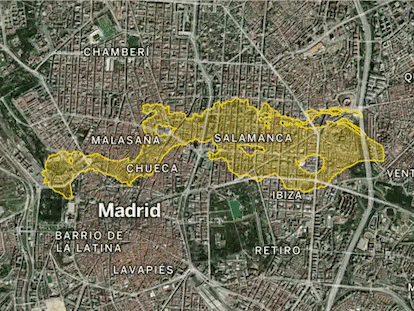As La Palma eruption intensifies, experts warn: ‘There are no signs of it ending’
Around 3,500 residents were confined after lava reached an industrial area, triggering a cloud of gas

Lava from the new volcano on La Palma, in Spain’s Canary Islands, has affected 595 hectares, the National Security Department (DSN) reported on Tuesday. Since the volcanic cone partially collapsed on Saturday, there has been a rise in effusive and explosive activity. This has led to more lava flows, with more liquid molten rock.
There are currently two branches from the main lava flow that are advancing north of Todoque mountain. The first has joined the previous flow and is moving quickly towards the Atlantic Ocean. The second, which is further north, reached an industrial area called El Callejón de la Gata in the town of Los Llanos de Aridane on Monday. As it advanced over factories in this area, it triggered a fire at a cement plant that led to a large cloud of “possibly toxic” gases, according to Pevolca technical director Miguel Ángel Morcuende.
In response, the Volcano Risk Prevention Plan (Pevolca), ordered the confinement of several areas in the towns of El Paso and Los Llanos de Aridane, a decision that affected around 3,500 people.
“As a result of the release of gases due to the combustion from the fire at the cement plant at Callejón de la Gata, and in anticipation of possible damage to nearby warehouses and scrapyards, the confinement will remain in place until it is reviewed,” Pevolca stated in a press release on Monday.
Civil Guard vehicles traveled around the affected areas, warning residents via a megaphone to stay inside and close all their doors and windows. But despite the warnings, the cloud of smoke – at times a radiant white and others a dark grey – attracted the attention of hundreds of onlookers. “If the Civil Guard throw me out, I’ll go, but until then, I am going to take photos,” said Sara, an amateur photographer from Tenerife, another island in the Canaries archipelago, which is located off the coast of northwestern Africa.
The confinement order due to the risk of toxic gases was lifted on Tuesday morning. This decision was made after a study of the gases from the first at the industrial warehouses was completed and the air quality checked.
The Callejón de la Gata was the latest area to be affected by the volcano, which has so far destroyed hundreds of homes, banana plantations and vineyards. “They are all businesses owned by local people who could be left with nothing,” said Abián Acosta, a manager at the avocado packing plant Agro Rincón, which is located in the area.
Many businesses, however, are insured. As of October 7, the Insurance Compensation Consortium, which is under the Economy Ministry, had paid more than €4.1 million in compensation to those affected by the eruption. But this was of little consolation to Acosta. “Yes, we were insured. So what? Where are we going to go now?” he asked EL PAÍS.
Live feed of the eruption of La Palma volcano
As of Monday, the lava from the volcano had affected 591.1 hectares, growing 65.33 hectares since Sunday. This is the largest daily rise since the volcano began erupting on September 19. Another 150 hectares of agricultural land have also been affected by the lava.
“The volcano remains very active,” said Ángel Víctor Torres, the premier of the Canary Islands, on Monday. “It has its own parameters and scientists are not daring to estimate when it could end.”
Indeed, Nieves Sánchez, a researcher from Spain’s Geology and Mining Institute (IGME-CISC), told EL PAÍS: “The volcano is not showing signs that it is going to end tomorrow nor the next day nor in a week.”
She explained: “The activity changes a lot from day to day, the cone was first built and later destroyed. In the last few days, we are seeing deeper seismic activity. [...] It could be reactivating, although we have to wait to confirm this by observing the exterior. My opinion is that it’s going to continue to erupt for some time. We don’t know how long, nor could we say so until the pattern of earthquakes and land uplift changes.”
Spanish Prime Minister Pedro Sánchez is scheduled to visit La Palma on Wednesday. This will be his fourth visit to the island since the eruption began.
Tu suscripción se está usando en otro dispositivo
¿Quieres añadir otro usuario a tu suscripción?
Si continúas leyendo en este dispositivo, no se podrá leer en el otro.
FlechaTu suscripción se está usando en otro dispositivo y solo puedes acceder a EL PAÍS desde un dispositivo a la vez.
Si quieres compartir tu cuenta, cambia tu suscripción a la modalidad Premium, así podrás añadir otro usuario. Cada uno accederá con su propia cuenta de email, lo que os permitirá personalizar vuestra experiencia en EL PAÍS.
¿Tienes una suscripción de empresa? Accede aquí para contratar más cuentas.
En el caso de no saber quién está usando tu cuenta, te recomendamos cambiar tu contraseña aquí.
Si decides continuar compartiendo tu cuenta, este mensaje se mostrará en tu dispositivo y en el de la otra persona que está usando tu cuenta de forma indefinida, afectando a tu experiencia de lectura. Puedes consultar aquí los términos y condiciones de la suscripción digital.
More information
Últimas noticias
Most viewed
- Reinhard Genzel, Nobel laureate in physics: ‘One-minute videos will never give you the truth’
- Oona Chaplin: ‘I told James Cameron that I was living in a treehouse and starting a permaculture project with a friend’
- Pablo Escobar’s hippos: A serious environmental problem, 40 years on
- Why we lost the habit of sleeping in two segments and how that changed our sense of time
- Chevy Chase, the beloved comedian who was a monster off camera: ‘Not everyone hated him, just the people who’ve worked with him’










































